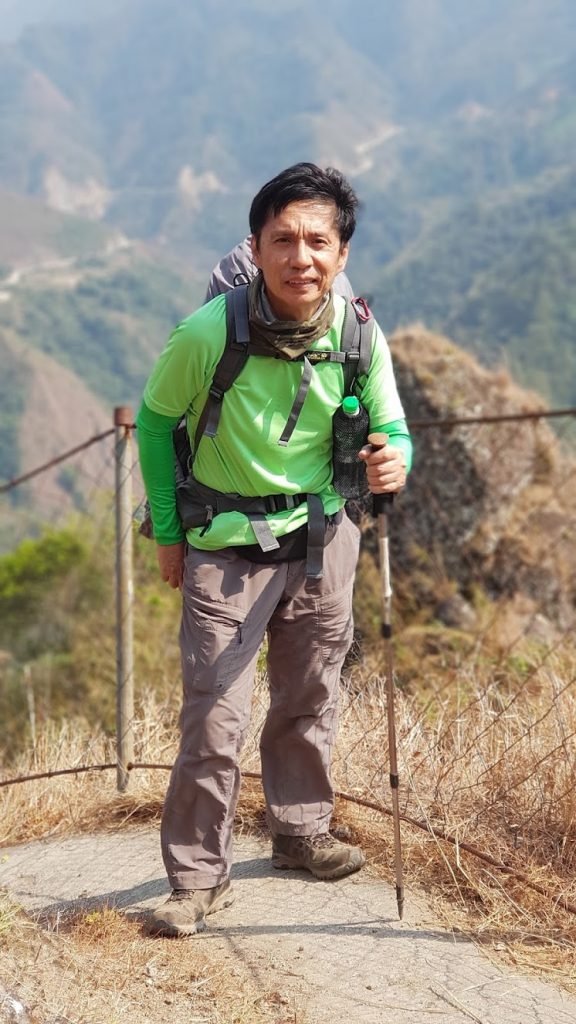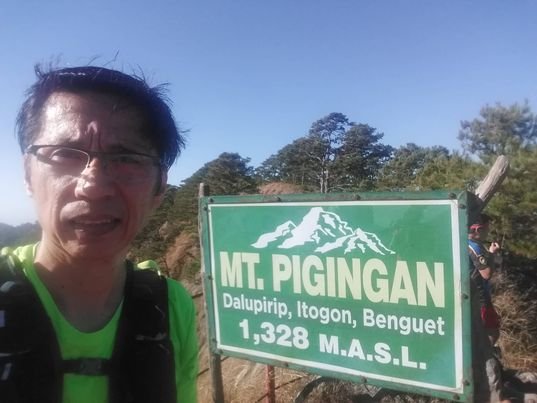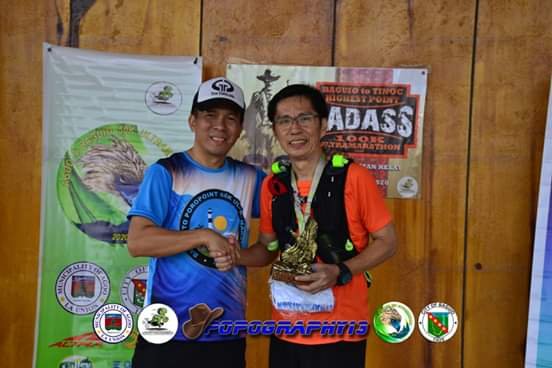I am an addict. I am addicted to running. It took a pandemic to stop me from hitting the road every morning five times a week. I got into running after experiencing physical pain doing a trek.

I was a late starter in outdoor activities. My first trek was at age 48. It was Mt. Pulag. Other treks followed but it was not until doing Bakun Trio in Bakun, Benguet (a 3-day hike up and down 3 mountains) in Aug 2017, at age 51, that I suffered what I would later know to be a Patellofemoral Pain Syndrome or PFPS. Patellofemoral Pain Syndrome is pain around the kneecap often caused by physical trauma.
On my return to Manila, I visited an orthopaedic specialist. X-ray was done. I was no longer in pain but my left thigh and knee still felt stiff. The doctor did a physical check-up on my leg while asking me a series of questions. The x-ray showed no injury. That and with the condition of my knee during the examination and my narrative, the doctor concluded what I had at Bakun was PFPS. He tried to explain it in layman’s language. He said my knee and thigh muscles were so tired it decided on its own to freeze so that I will be compelled to stop and rest. Fatigue is a mechanism of our body to protect itself from possible harm. Tired knees, must rest.
During the trek from Mt. Kabunian back to camp was when I had PFPS. It was a confusing injury for me. I can stand on my left leg, put weight on it and feel no pain. But I felt pain bending my knee. I can only imagine the pain of going down a mountain with one stiff leg.
The doctor recommended therapy and regular exercise thereafter. He added, given my age, if I have to engage in this type of activity I have to prepare well. I cannot go inactive for weeks or months and do a major trek on short notice. Given my age, muscles cannot be activated by mere will and desire. You have to work on being fit.
So I took up running. Well, I tried but I cannot… at the start.
There was pain on my side whenever I tried to run. I settled for morning walks instead. Occasionally I will do a slow jog. Did a lot of stretching and regularly did exercises I learned from the therapy. I didn’t run until much later. Not until Sept 2018. I egged myself to run because I got bored with the walks and slow jogs. Ran 3 times a week. I reached the condition of doing 2 to 3 km on weekdays and 4 or 5 km on Sundays. On about 2 occasions I went for 10km just for the fun of it.
I was contented with my routine. I was running for wellness, waiting for the next invite to do a trek. Then on the first weekend of July 2019 at the University of the Philippines Academic Oval, I noticed an unusual number of runners wearing Milo Marathon singlets. I have been running in the campus for months every weekend and this is the first time I noticed this color en masse on a Sunday morning and I know there is no race that day on the campus. Much less a Milo event.
When I got home, out of curiosity I checked online and found out the Metro Manila leg of Milo Marathon was scheduled on the last weekend of July. That’s barely four weeks away. Obviously, that group of runners was preparing for that race.
My First 21K, After Injury
It piqued my interest. I have not run a marathon or any road race at any distance though I have been doing running as an exercise for the past nine months. Would it not be fun to try, I whispered to myself. But do I have enough time to prepare? Searched online for a training program for those wanting to run a 42K for the first time. Twelve weeks was the shortest I found and it required two training runs of 20km. This won’t do. I decided to be less ambitious and compromised. Will do a 21K instead.
Searched for 21K training programs. Eight weeks was the shortest program I can find and will require two training runs of 12km. Well, I have been running for nine months now, it should amount to something to cover the first 5 weeks of the training and I will just follow the remaining 3 weeks. So I did.
The cut-off to earn a Finisher’s Medal for 21K was 2 hours and 30 min. I did 2:24. I have been bitten by the running bug.
The 42k Philippine Marine Corps Marathon
The same day after my first 21K, when I got home I checked the race calendar online. I want a 42K. Found one. October 27, 2019 the Philippine Marine Corps Marathon in Ternate, Cavite.
This will be the 5th edition of the Philippine Marine Corps Marathon. This is a road race along the highway linking Ternate, Cavite to Nasugbu, Batangas. The most popular landmark along this route is the Kaybiang Tunnel. I have a little less than 3 months to prepare. Doable, I said. More so, I read while preparing for the 21K that a prior race can be part of your training for the next race. Just completed a 21, 42 is a logical progression. Wink, wink.
I trained. I felt good going into the race.
This marathon- The Philippine Marine Corps Marathon is not a marathon by its common notion. It is a hybrid race, in my opinion. Yes, it has a marathon distance of 42 kilometers, but the route is a highway laid out on the mountain bordering Ternate, Cavite and Nasugbu, Batangas. For one who has done trekking, aside from the distance, another consideration here was the elevation change or profile of the route. The route will go up, then down. Up, then down again. Even minor treks can have short stretches of incline. Some stretches will be kind and flat, but it won’t be flat that long. The PMCM route has the profile of a mountain trail; though the route is a highway, well paved and wide.

I trained for the distance; I didn’t train for the elevation changes.
Only during the race did I realize the route was too technical for me. I don’t know the proper technique running uphill or downhill. Even before reaching the U-turn at the 21K mark, I can feel stiffening on both my thigh muscles.I slowed down to a jog even before the halfway mark. I worried on missing the cut-off of 8 hours. I had aimed to finish in less than 6 hours, but now I cannot continually run for long stretches. Well, if I fail, I will fail trying.
There was one point when a military truck passed by and the soldiers offered me a ride. They saw me walking, not running. They saw I was struggling. I politely declined.
Run, walk, run, walk that’s what I did and crossed the finish line in 6:59, 100th in the field of about 120 finishers.Lesson learned. It is not just the distance. Study and train for the route profile as well.
The running bug that bit me was venomous. The pain of the PMCM had me aching for another race.

My First 50K run
Agoo, La Union to Baguio City- I signed up for my next race – a 50K ultra marathon. I have full three months to prepare.
This is a road race. I know I can handle the distance. It is the elevation change I have to contend with. To prepare for uphill running, I did my weekend run along Sumulong Highway going to Antipolo. Ran from Masinag to Antipolo, a distance of a little bit less than 10km. Did this three times on separate weekends. Also did one practice run from Padilla to Sampalok, Tanay in Rizal a distance of 30km.

This Agoo to Baguio run was in contrast to my last. Here I was not in pain. I was a happy runner here. My time was 9:04, well within the cut-off of 11 hours. My goal was to finish in 10. I could have finished under 9 hours but I took an early turn going to Burnham Park where the finish line was. That early turn made me cover more distance in the city leading to the park. But I was happy just the same.

Tailender
There was an amusing incident during this race. I planned to run with average pace, to finish and end the run at roughly the same average pace. After about five kilometers, the runners in front of me were about 5oo meters ahead. I look behind there were three runners. I kept my pace and eventually overtook two runners. Then I arrived at the first aid station. The race director was there and asked if I noticed how many other runners were behind me. I replied I overtook two and before that were three behind me. The race director then said those three were sweepers.
I was momentarily stunned. I didn’t realize I was at the tail end at that point of the race.
But I know my pace is good to meet my goal of 10 hours. I thought maybe the field is simply strong. But I was decided on running at my own pace and did not change my plan. In fact I ran the last 20 km faster than the first 20 and reached the finish ahead of 20 other participants. Yes, I was not last in the final reckoning.
But this will not be the last incident where I will be the tail ender at one point of the race.
Sheepish on My First Trail Run
The Monday after, I was again looking at the race calendar. I want to experience a real trail run. I have done a 50K road race, I was now looking for a 50K trail run.
Here I found out race organizers of trail runs will not allow you to sign up for the 50k unless you have run a shorter trail run. You have to do those 10Kto 12K trail run before you can do a 25K to 30K. After completing a 25K-30K would you be allowed to sign up for a 50K. So I signed up for a 30K, the Marikit-Pigingan (MP30K) trail run in Itogon, Benguet organized by the King of The Mountain- Trail Run Philippines.
I first inquired if I may be allowed to sign up for the 30K even with no prior trail run finish. I narrated that I have completed the Philippine Marine Corps Marathon which was on a mountainous route and I have done major treks to Pulag, Bakun Trio and Kibungan Circuit that will show I can handle any possible issues with the altitude. This race has a peak elevation of 1,363 MASL. The organizer was also the race director of the PMCM which was described in its FB page as arguably the most difficult marathon race in the country. Finishing the PCMC allowed me to sign up for this MP30K trail run.
Race day was February 16, 2020. A mere two weeks after the 50K. Crazy me.
The MP30K will have runners negotiate two peaks. The first has a 7km long uphill trail and the second has 3km. I was okay going up. Going down caused some issues. On the first downhill, I felt the pounding on my knees. I immediately held back and decided to walk going down to protect my knees. I will just increase my pace along the less punishing stretches of the trail, I told myself.
On the first downhill, as I was concentrating on my footing, I noticed there were two guys behind me. I was slow and blocking the trail and it would not be right to hold back other runners. I stepped aside and said, “Ahead”, I gave way for them to overtake. With a smile, one of them replied, “No, sir, sweeper po kami.”
Again, I was the last runner at a point of the race!
This was somewhere between the 15th and 16th km stretch of the race. I had a sheepish smile. But I kept with my walk downhill. There is still a long run ahead and hopefully I can make up for lost time in the last 7km stretch which was relatively flat. The last aid station was positioned at the 25th kilometer. At this aid station runners who arrived ahead of me seemed decided to spend more time to rest before proceeding. I felt okay to proceed immediately. I refilled my water bottle and immediately continued.
Race cut-off was set for 10 hours at 3pm. It was not yet 12 noon when I left the aid station. I finished the run in 8 hours and 23 minutes. About 10 other runners came after me.
Later I met the sweepers and with a smile on my lips, laughter in my eyes I said, “O, ayan di ako bugaw ha.” They smiled approvingly.
The bus ride back to Manila had me thinking of my next run. By this time I am now hooked. Addicted to running.
I want to complete a 50K trail run with the aim of eventually participating in a 100K later. Can I manage a 50K and eventually a 100K run? Yes, but with some uncertainties.
There are a lot to consider aside from the distance. There is the question of what food to take during the run, what gears to carry, weather and temperature changes, and nighttime running. All these are factors in completing a 100K.
Training at Mt. Pulag’s Tawangan- Ambangeg Trail
At this time, I have been invited to join a trek to Mt. Pulag. This is supposedly a traverse from Tawangan trail, one of the more difficult, wild paths of Mt. Pulag, to the so-called killer trail of Akiki, but unfortunately, the Akiki route had to be closed due to a forest fire threat. I decided to use this trek to test a meal refueling plan for the 100K race.

That weekend of the trek, I had my last full meal Thursday evening before I left Manila for Baguio. I didn’t take any rice meal until the end of the trek at Babadak Ranger Station Sunday past 3 pm. In between Thursday evening and Sunday afternoon I just ate cereal bars and dried fruits. Salt tablets helped as well. I did this to test if I can withstand a weekend with no regular full meals while doing extreme physical exertion.
This self-test was completed with good results indicating I may just manage 100K. I finished the trek in high spirits. The estimated 12-hour trek from jump-off to saddle camp at Mt. Pulag is not 100K. But with a 15-kilo gear on my back on a 6/9 rated trail and limiting my food to cereal bars and dried fruits, depriving my body of full hot meals for two days is, in my opinion, a good gauge if I can endure with this kind of refueling.
Feeling good without regular meals for over 48 hours while traversing Mt. Pulag, I have decided to pursue a 100K. But first I have to complete a 50K trail run as a pre-requisite. To save my knees during the run I decided to use trek poles which is allowed at this distance. I immediately bought a pair online so I can use it during my training runs and get used to carrying it. My mind was set on the 100K trail but first I must finish a 50K. There is one scheduled on March 21, 2020.
March 2020 came. Then the pandemic happened. Lockdowns were imposed worldwide, and I can only sigh in resignation hoping the pandemic will come to an end soon.






